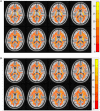Machine Learning Analysis Classifies Patients with Primary Angle-Closure Glaucoma Using Abnormal Brain White Matter Function
- PMID: 38468914
- PMCID: PMC10926922
- DOI: 10.2147/OPTH.S451872
Machine Learning Analysis Classifies Patients with Primary Angle-Closure Glaucoma Using Abnormal Brain White Matter Function
Abstract
Objective: Primary angle-closure glaucoma (PACG) is a globally prevalent, irreversible eye disease leading to blindness. Previous neuroimaging studies demonstrated that PACG patients were associated with gray matter function changes. However, whether the white matter(WM) function changes in PACG patients remains unknown. The purpose of the study is to investigate WM function changes in the PACG patients.
Methods: In total, 40 PACG patients and 40 well-matched HCs participated in our study and underwent resting-state functional magnetic resonance imaging (rs-fMRI) scans. We compared between-group differences between PACG patients and HC in the WM function using amplitude of low-frequency fluctuations (ALFF). In addition, the SVM method was applied to the construction of the PACG classification model.
Results: Compared with the HC group, ALFF was attenuated in right posterior thalamic radiation (include optic radiation), splenium of corpus callosum, and left tapetum in the PACG group, the results are statistically significant (GRF correction, voxel-level P < 0.001, cluster-level P < 0.05). Furthermore, the SVM classification had an accuracy of 80.0% and an area under the curve (AUC) of 0.86 for distinguishing patients with PACG from HC.
Conclusion: The findings of our study uncover abnormal WM functional alterations in PACG patients and mainly involves vision-related regions. These findings provide new insights into widespread brain damage in PACG from an alternative WM functional perspective.
Keywords: amplitude of low frequency fluctuations; primary angle-closure glaucoma; support vector machine; white matter.
© 2024 Tang et al.
Conflict of interest statement
The authors report no conflicts of interest in this work.
Figures




Similar articles
-
The Predictive Values of Changes in Local and Remote Brain Functional Connectivity in Primary Angle-Closure Glaucoma Patients According to Support Vector Machine Analysis.Front Hum Neurosci. 2022 May 19;16:910669. doi: 10.3389/fnhum.2022.910669. eCollection 2022. Front Hum Neurosci. 2022. PMID: 35664342 Free PMC article.
-
Machine learning analysis reveals abnormal functional network hubs in the primary angle-closure glaucoma patients.Front Hum Neurosci. 2022 Aug 24;16:935213. doi: 10.3389/fnhum.2022.935213. eCollection 2022. Front Hum Neurosci. 2022. PMID: 36092649 Free PMC article.
-
Frequency-dependent neural activity in primary angle-closure glaucoma.Neuropsychiatr Dis Treat. 2019 Jan 18;15:271-282. doi: 10.2147/NDT.S187367. eCollection 2019. Neuropsychiatr Dis Treat. 2019. PMID: 30697052 Free PMC article.
-
Genetic susceptibility to primary angle closure glaucoma (PACG).Discov Med. 2013 Jan;15(80):17-22. Discov Med. 2013. PMID: 23375010 Review.
-
Blindness in glaucoma: primary open-angle glaucoma versus primary angle-closure glaucoma-a meta-analysis.Eye (Lond). 2022 Nov;36(11):2099-2105. doi: 10.1038/s41433-021-01802-9. Epub 2021 Oct 13. Eye (Lond). 2022. PMID: 34645961 Free PMC article.
Cited by
-
[1H-13C]-NMR-Based Metabolic Kinetics Reveals Brain Neurochemical Alterations in Mice After Retinal Ischemia-Reperfusion Injury.Mol Neurobiol. 2025 May;62(5):5758-5773. doi: 10.1007/s12035-024-04641-3. Epub 2024 Dec 2. Mol Neurobiol. 2025. PMID: 39621232
References
LinkOut - more resources
Full Text Sources

